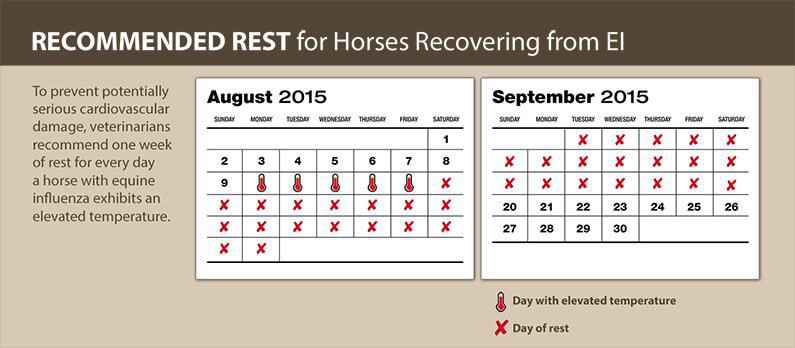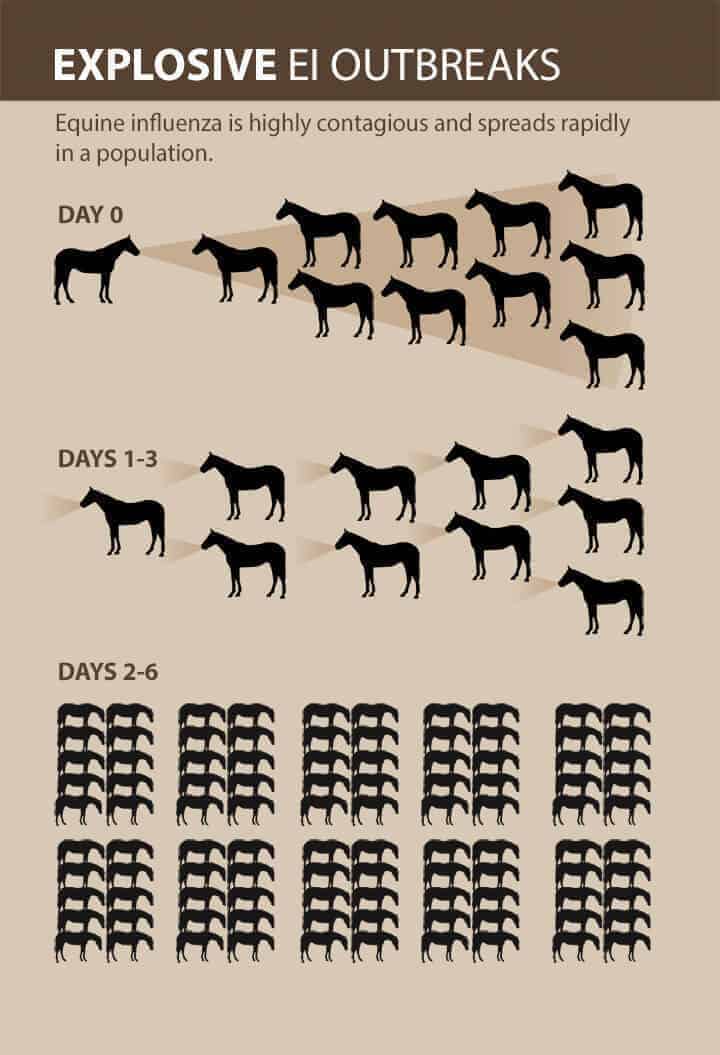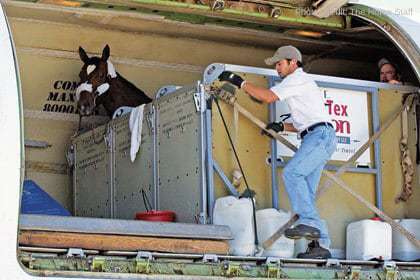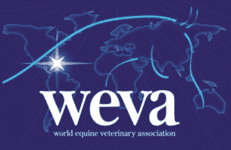Equine influenza is a highly contagious respiratory virus that can put horses out of work for weeks and potentially cause serious secondary infections. Learn how to protect your horse, and your plans, from this rapidly spreading disease.
Picture yourself going out to the barn shortly after
daybreak to feed and finding the gelding you competed last weekend—and intended to show this weekend, as well—coughing, with a prolific watery nasal discharge (which might thicken with time). You notice that his lymph nodes are enlarged and he’s lethargic, not wanting to move. You fetch your thermometer and find that his temperature is elevated from its usual baseline of 100°F.
You call your veterinarian and leave an urgent message. When she arrives, she examines your horse and tells you she suspects he has contracted equine influenza (EI), a highly contagious respiratory disease. Your heart sinks.
This means you’re not showing your horse next weekend. In fact, for every day your horse has an elevated temperature, your veterinarian says he’ll need a week of rest to prevent potential long-term damage to his heart. Your entire training and showing schedule for the season is now up in the air, as are the schedules of all horses exposed to your sick horse—horses at the show last weekend and any in his barn this week.

EI Diagnosis and Treatment
Based on a differential diagnosis, your veterinarian recommends simple supportive care, which includes:
- A clean, well-ventilated stall or paddock to rest in (read: free from dust that could aggravate his respiratory tract).
- Plenty of hay and clean water (although your horse will likely not be interested for several days).
- Banamine (flunixin meglumine) to lower his temperature and help him feel better, keeping him eating and drinking.
She adds that, as with human influenza, unless a secondary bacterial infection ensues (in which case she’d prescribe antibiotics), treatment consists simply of rest and waiting for the virus to run its course.
“Testing involves a nasopharyngeal swab,” says Dr. Thomas Chambers of Gluck Equine Research Center, in Lexington, Kentucky, a leading expert on the disease. “It’s a swab about a foot up the horse’s nose, which vets don’t always like to put a horse through.”
Thus, the incidence of EI isn’t fully known or monitored. But suffice it to say that EI is widespread in the United States and, with a handful of exceptions, the rest of the world as well.
Differential Diagnosis:
Lorem ipsum dolor sit amet, consectetur adipiscing elit. Ut elit tellus, luctus nec ullamcorper mattis, pulvinar dapibus leo.

Thomas Chambers, PhD.
represents the United States on the World Organization for Animal Health’s (OIE) expert surveillance panel, which meets each year to review the status of EI worldwide. The panel also makes recommendations to vaccine manufacturers for updating their EI vaccines to keep them effective against the most currently circulating strains of EI virus. Chambers runs the only OIE reference laboratory for equine influenza in the Western Hemisphere, located at Gluck Equine Research Center, in Lexington, Kentucky.
How Long Until We're Back in the Game?
Equine influenza can keep you and your horse out of
competition for three or more weeks while his damaged respiratory tissues heal.
“We push for (at least) two weeks of rest after coughing stops,” says Dr. Langdon Fielding, who treats horses infected with EI regularly at his Penryn, California, equine veterinary practice.


Langdon Fielding, DVM. Dipl. ACVECC.
received his veterinary degree from the University of California, Davis, School of Veterinary Medicine. He interned at Texas A&M University, focusing on large animal medicine and surgery, then returned to California to practice at Loomis Basin Veterinary Center in Penryn. His primary interest is in emergency medicine. He’s is board certified in equine critical care.
The El Viral Invader
Equine influenza is a viral disease. A virus, Chambers
explains, is basically a container for moving genes from one cell to another, with the virus trying to take over the host’s—your horse’s—cells.
The EI viral invaders accomplish their takeover through antigenic drift—viruses’ mechanism for mutating that keeps the host’s immune system from recognizing and fighting them. It’s this variation that breaks influenza virus lineages into sublineages and then into clades.
From EI outbreaks reported in 2014, scientists at the Office International des Epizooties, or World Organization for Animal Health (OIE, which meets annually to review EI’s status worldwide and make vaccine inclusion recommendations) isolated equine influenza A (H3N8), which infects the horse’s respiratory tract. Viruses detected in the United States were mainly Florida Clade 1 viruses; those detected in Europe were mainly Florida Clade 2.
At one time, the Eurasian lineage, named for its location, was prominent, but Chambers wonders whether it might now be extinct. “I’m not aware of a confirmed case since around 2007,” he says. The OIE’s expert surveillance panel has most recently recommended vaccines contain Florida Clades 1 and 2 and has discontinued recommending the Eurasian lineage. And, although viral lineages change continually, Chambers says that in horses, the process has been slow enough that for 2015 the OIE’s Expert Surveillance Panel recommended no changes to EI vaccines.
Virus:
An infective agent that typically consists of a nucleic acid molecule in a protein coat, a virus is too small to be seen by light microscopy and is able to multiply only within the living cells of a host.
El's Potentially Explosive Spread
“Equine influenza is the second most common virus in
horses, following equine herpesvirus-4,” says Dr. Nicola Pusterla, an internal medicine specialist at the University of California, Davis. “The overall frequency depends on the horse population you’re considering. Infection in backyard horses will be relatively low due to the limited contact they have with potentially infected horses.”
But in performance horses that are under stress and come into regular contact with large, transient populations and potentially unvaccinated horses, or who might encounter substandard hygienic conditions, the likelihood of infection is higher.

Young horses and older horses are more susceptible,” Pusterla adds, “and infection would depend a bit on the (virus) strain too. Of horses exposed to the virus, a very high percentage will develop EI.”
Equine influenza spreads mainly through coughing, via respiratory droplets, potentially exposing large numbers of nearby horses (think show stables or training barns with many transient horses).


Nicola Pusterla, DVM, PhD, Dipl. ACVIM,
is a professor in equine internal medicine and chief of large animal medicine services at the University of California, Davis, William R. Pritchard Veterinary Medical Teaching Hospital. He graduated from the School of Veterinary Medicine at the University of Zurich, Switzerland, in 1991 and also earned his PhD there with an emphasis on vector-borne diseases.
In a 2007 EI outbreak in Australia—a country that until
then was EI-free—eight infected horses that were imported on Aug. 8 led to an infection peak by Sept. 24 of nearly 1,000 cases per week. The disease’s rapid spread in Australia paralyzed the country’s horse industry, causing canceled horse races and shows, keeping police horses off the streets, and reducing the number of breedings and the subsequent foal crop.
Dr. Mark Schipp, Australia’s chief veterinary officer and vice president of the OIE, says it took a government response plan and more than 1,500 horse industry participants to quell the outbreak in New South Wales and return Australia to its EI-free status.
The Australian plan to control EI included:
- Locking down all horse movements to confine the virus;
- Quarantining infected properties and areas;
- Defining zones on the basis of risk;
- Creating buffer zones; and
- Developing new, rapid laboratory tests for accurate diagnoses.
Before the outbreak—and ever since Australia’s speedy eradication of EI in less than one year—the EI vaccine was and continues to be under strict control in Australia. “A horse owner can’t just go ahead and have their horse vaccinated (whenever they want to) as they can in the U.S.,” says Chambers, who’s the U.S. delegate to the OIE’s expert surveillance panel for EI.
But horses don’t have to ship internationally to spread the EI virus. Transmission paths include:
- Introducing a new infected horse into your herd that might or might not exhibit clinical signs.
- Direct contact with people, tack, equipment, and surfaces that have been exposed to/contaminated by virus aerosolized by an infected, coughing horse.
- Contact with wild equine populations. A May 2015 outbreak in Arizona was discovered when dead wild burros tested positive for EI.
Fortunately, the mortality (death) rate associated with EI is very low, says Pusterla, adding that serious complications include the secondary bacterial infections mentioned and resulting bronchial pneumonia, which can be serious.
Veterinarians detect these secondary infections using blood counts and possibly X rays and ultrasounds and treat them with antibiotics as needed, adds Fielding. Although not common, viral pneumonia can be deadly in foals that lack maternal antibodies.

Dr. Mark Schipp
has served as Australia’s chief veterinary officer since 2011. He represents Australia in the World Organization for Animal Health, where he serves as vice president. He has also been active in leading Australian agriculture’s response to the global threat of antimicrobial resistance.
Shipping Internationally and El Risk

Because equine influenza has been endemic in the United States since 1963, it’s not a reportable disease here (meaning it does not have to be reported to the government), so animal health officials don’t routinely impose quarantine during EI outbreaks in the United States.
However, if your horse is traveling outside the United States for competition or other reasons, he’s subject to regulations imposed by the particular country to which he’s traveling.
Where do you go for information on your destination country’s importation regulations and procedures? www.oie.int.
The OIE is composed of representatives from 180 countries. Among myriad other tasks, the OIE:
- Monitors shifts in EI strains and recommends EI vaccine updates to manufacturers when needed.
- Works to harmonize travel and quarantine restrictions for competition horses from country to country.
Because the equine influenza virus is so widely spread, says Chambers, eradication in the United States won’t happen. He advises you—the competition horse owner—to be aware that the disease is here; that there are vaccines for it; and to consult your veterinarian about developing appropriate immunization and biosecurity protocols for your particular horses and circumstances.
Finally, he adds, “When your horse does have respiratory disease, work with your veterinarian to get diagnostic samples sent promptly to your regional veterinary diagnostic laboratory, to his own lab, or to Pusterla (at the UC Davis lab). Ideally these would be swab samples, but serum samples from blood (paired acute and convalescent, meaning from the same horse at time of illness and again three to four weeks later) are better than nothing. Don’t wait, and don’t put it off until your horse feels better. Promptness can make the difference between diagnostic success and failure.”
What Steps Can I Take to Keep My Horse El-Free?
Whether you’re at home, on the road, or at a public
facility, you can protect your horse by upping your hygiene game:
- Isolate all horses arriving on your property for 28 days, as recommended by OIE.
- Use only your own (sanitized) equipment for feed, water, grooming, and other care.
- Disinfect tack and equipment that might have been used on or near infected horses (at a show, for example).
- Thoroughly wash your exposed skin (with antiseptic soap) or clothing that might have come into contact with the virus.
- If your horse exhibits clinical signs consistent with EI, call your veterinarian immediately.
- Ensure that those who care for your horses—veterinarians, farriers, grooms, trainers, and others—practice preventive hygiene as well.
Vaccinating for El
The American Association of Equine Practitioners (AAEP)
includes EI as a risk-based vaccine, which means veterinarians include it in a vaccination program after the performance of a risk-benefit analysis. But does vaccination guarantee your horse won’t get the disease? Pusterla says no.
“All the vaccines are labeled as aids, not as prevention,” he stresses. “They’re tools to minimize the effects of infection.” Not vaccinating increases your horse’s risk for contracting EI if exposed, he says, adding that, “among unvaccinated horses with no prior exposure to the virus, a high number will become infected.”
Sometimes vaccines fail due to the virus strain mutating, rendering the vaccine less effective (or ineffective). This is why the OIE monitors vaccines constantly and updates them as virus strains change.
Pusterla cites three specific benefits of vaccination:
- Infected horses won’t get clinically sick;
- Viruses won’t replicate as much; and
- Risk for disease transmission decreases.
Veterinarians use three types of vaccines against EI:
| Vaccine Type | Description | Upside | Downside |
|---|---|---|---|
| Killed (aka inactivated) virus | Given intramuscularly | Dead microbes can’t mutate back to their disease-causing state | Tends to stimulate a weaker immune system response than live vaccines, so periodic boosters are necessary to maintain effectiveness |
| Modified-live virus (aka live, attenuated) | Intranasal; uses an active but weakened form of the virus | Effectively stimulates cell-mediated (non-antigen) immunity, so it’s relatively long-lasting | Slight risk that the inactive virus can revert to the true virus form and that the vaccine could infect immunocompromised horses |
| Recombinant vector vaccines (the canarypox vectored vaccine for EI) | Intramuscular administration; certain proteins from a safe live EI virus are introduced via the shell of canarypox, which is innocuous to horses | Its effect on the cellular level closely resembles a natural infection, so it stimulates the immune system well | Like attenuated virus vaccines, it could cause disease in immunocompromised horses |
Talk with your veterinarian to formulate a vaccination plan and schedule. For more information, see the AAEP’s EI vaccination guidelines.
Can I Catch El From My Horse?
Chambers says scientists have not confirmed any case of
a human getting sick from a natural infection with EI. But, viruses can adapt from one species to another. Case in point: In 2004 the H3N8 equine influenza virus genome transferred to dogs, forming a new canine-specific virus—an event that the American Veterinary Medical Association calls “a very rare event in adaptive evolution.”
And in at least one study scientists found that they could experimentally infect cats with H3N8, causing them to shed and transmit the virus. While very little risk exists for humans to contract EI, humans have developed antibodies to the virus after exposure to infected horses—although no humans have become ill following exposure.
Take-Home Message
Other than making horses feel generally unwell, equine
influenza’s major impact is economic:
- Competition and training days lost due to layups and quarantines;
- Veterinary costs associated with diagnosis, care, and possible secondary infections, and
- Event cancellations due to outbreaks.
An influenza infection’s financial impact can reach $885 per horse, which includes diagnostics, treatment, and time off from training and competition. Vaccination, coupled with impeccable hygiene practices, will provide your horse with the best possible chance of coming home EI-free from each event you attend this season.

Diane E. Rice earned a bachelor’s degree in agricultural journalism from the University of Wisconsin, then melded her education and her lifelong passion for horses in an editorial position at Appaloosa Journal. She currently works as a freelance writer, editor, proofreader, and photographer and has served on American Horse Publications’ board of directors. Rice spends her spare time gardening, reading, serving in her church, and with her daughters, grandchildren, and pets.
Editor-in-Chief: Stephanie L. Church
Digital Managing Editor: Michelle Anderson
Editorial Team: Alexandra Beckstett, Erica Larson
Art Director and Graphics: Brian Turner
Digital Producer: Jennifer Whittle
Publisher: Marla Bickel





